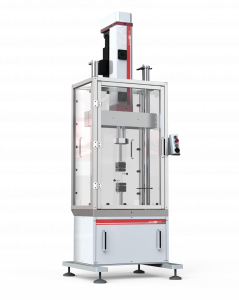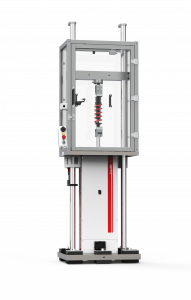What is a fracture test?
Fracture toughness test is one of the most important mechanical tests aimed at understanding a material’s ability to withstand crack growth, which is a key aspect of fracture mechanics and influences the material’s overall fracture resistance, an essential component of material characterization.
This comprehensive guide explores fracture toughness testing in the context of fracture mechanics, elucidating its significance, methodologies, standards, advantages, and proper testing machines.
What does fracture test measure?
Fracture toughness tests epitomize the evaluation of a material’s resilience against crack growth by subjecting it to a progressively increasing load until failure. The initiation of fracture failure typically stems from inherent flaws within the material, such as scratches, dents, or corrosion sites, propagating into critical cracks leading to structural failure. These tests, often conducted in conjunction with corrosion, fatigue, or elevated temperature assessments, provide invaluable insights into a material’s performance under diverse environmental conditions.
What is the purpose of fracture testing?
Fracture toughness tests offer profound insights into a material’s structural integrity and durability, crucial elements of fracture mechanics used across many industries. A material exhibiting high fracture toughness signifies enhanced resistance to crack growth, indicative of superior damage tolerance and fatigue resistance. Consequently, these tests play a crucial role in material selection, design optimization, and ensuring operational safety across myriad engineering disciplines.
- Determine the safety of the material.
- Determine the life of a material.
- Cost savings through reduced premature maintenance.
How to perform a fracture test?
Fracture toughness testing involves applying incremental loads to the material until it reaches failure, following core principles of fracture mechanics. Prior to testing, meticulous preparation is imperative, involving the creation of a fatigue notch to facilitate crack initiation, commonly achieved through Electric Discharge Machining (EDM).
To conduct a fracture toughness test, the initial step entails the preparation of a testing sample featuring a pre-existing crack. This crack facilites intended crack propagation during the test. Utilizing a universal testing machine (UTM) is imperative for conducting fracture toughness tests, given its versatility in accommodating various testing methodologies, including tensile testing. Moreover, adherence to reference standards is paramount, as prescribed by renowned organizations such as ASTM and ISO. These standards delineate specific requirements concerning machine calibration and test setup, ensuring procedural uniformity across diverse testing scenarios.
One common method employed in fracture toughness testing is the Crack Tip Opening Displacement (CTOD) test. This method entails subjecting a pre-cracked material specimen to a 3-point bend test setup. The procedural steps for conducting a CTOD test are as follows:
- Sample Preparation: Machining a notch at the midpoint of the material specimen, followed by inducing a fatigue crack at the machined notch.
- Loading Procedure: Placing the specimen within a 3-point bending setup machine to apply the requisite load.
- Strain Measurement: Attaching strain gauges to either side of the crack to meticulously measure strain variations throughout the testing process.
- Failure Analysis: Applying a progressive load until failure occurs, meticulously documenting the ensuing results for comprehensive analysis and evaluation.
Popular standards in fracture testing
- ASTM D5528: For interlaminar toughness of unidirectional polymer composites.
- ASTM D6671: Standard test method for mixed Mode I-Mode II interlaminar fracture toughness of unidirectional fiber-reinforced polymer matrix composites.
- ASTM E208: Standard Test Method for Conducting Drop-Weight Test to Determine Nil-Ductility Transition Temperature of Ferritic Steels.
- ASTM E399: Standard test method for linear-elastic plane-strain fracture toughness of metallic materials.
- ASTM E561: Standard Test Method for KR Curve Determination.
- ASTM E604: Standard Test Method for Dynamic Tear Testing of Metallic Materials.
- ASTM E740: Standard Practice for Fracture Testing with Surface-Crack Tension Specimens.
- ASTM E1304: Standard Test Method for Plane-Strain (Chevron-Notch) Fracture Toughness of Metallic Materials.
- ASTM E1681: Standard Test Method for Determining Threshold Stress Intensity Factor for Environment-Assisted Cracking of Metallic Materials.
- ASTM E1820: Standard Test Method for Measurement of Fracture Toughness.
- ASTM E1921-22a: Standard test method for determination of reference temperature, T0, for ferritic steels in the transition range.
- ISO 12135: Metallic materials—Unified method of test for the determination of quasi-static fracture toughness.
- ISO 17281: Plastics—Determination of fracture toughness (GIC and KIC) at moderately high loading rates (1 m/s).
Fracture testing machines
STEP Lab is synonymous with excellence in material testing, boasting unparalleled proficiency in the field. With our advanced electric testing machines, we excel in conducting precise fracture toughness evaluations. Whether it’s high load capacities or extreme temperatures, our facility is equipped to handle diverse testing conditions, guaranteeing reliable testing aligned with fracture mechanics requirements to meet diverse client needs.
EA SERIES
Electromechanical actuators
UD SERIES
Linear motor testing machines
FAQ
1. What is fracture mechanics, and how does it relate to material testing?
Fracture mechanics is an engineering field that explores how and why materials fracture under load, focusing on the propagation of flaws. Through fracture mechanics, material tests help understand a material’s resistance to crack growth, providing essential data to prevent structural failures.
2. How does crack growth influence material selection?
Crack growth is a key indicator of a material’s durability and lifespan. In fracture mechanics testing, the rate at which a crack expands under different loads and environmental conditions is analyzed. This information is vital for selecting materials capable of long-term performance, particularly in critical environments.
3. What techniques are used to measure crack growth in fracture toughness tests?
In fracture mechanics tests, methods such as Crack Tip Opening Displacement (CTOD) are employed to measure crack growth in real-time. These techniques allow for precise data on material resistance, enabling engineers and researchers to assess material longevity across various applications.
4. What are the benefits of using fracture mechanics for testing advanced materials?
Fracture mechanics provides precise tools and methods for analyzing how advanced materials respond to crack growth. The test results support the development of stronger, safer materials, optimizing both product design and performance in innovative applications.




